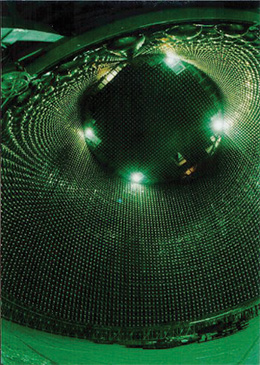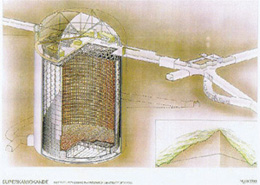 Located in Japan, Super-Kamiokande is a detector that studies the elisive particles known as nertrinos. This is a picture of the detector wall and top with about 9000 photomulitiplier tubes which help detect the neutrinos.  |
The 2002 Nobel Prize in Physics has been awarded to three physicists who have made pioneering contributions to astrophysics. Raymond Davis, Jr., a professor of physics and astronomy at the University of Pennsylvania, and Masatoshi Koshiba of the International Center for Elementary Particle Physics at the University of Tokyo in Japan, were honored "for pioneering contributions to astrophysics, in particular for the detection of cosmic neutrinos." The other half of the prize went to Riccardo Giacconi of Associated Universities, Inc., in Washington, DC, "for pioneering contributions to astrophysics, which have led to the discovery of cosmic x-ray sources." The work of these three men led to the establishment of two new branches of astrophysics, those involving x-rays and neutrinos.
Neutrinos are important in astrophysics since they might have played a considerable role in shaping early galaxies; they are the form of energy coming directly from the solar core; and they account for the largest share of energy released during supernova explosions. The development of instruments to observe x-ray sources outside our solar system has led to many notable discoveries, including the detection of an x- ray background and the detection of x-rays from a variety of sources, such as comets, black holes, quasars, and neutron stars.
Neutrinos are formed in the fusion processes in the Sun and other stars when hydrogen is converted into helium, and they are difficult to detect because they hardly interact at all with matter. In the 1960s, Davis placed a tank filled with 615 tons of tetrachloroethylene, a common cleaning fluid, in a gold mine in South Dakota, with the expectation that every month approximately 20 neutrinos ought to react with the chlorine, evidenced by the creation of 20 argon atoms. The experiment gathered data until 1994, extracting about 2,000 argon atoms in all, much fewer than expected. One explanation for this discrepancy was that some electron neutrinos produced in solar fusion reactions convert into other neutrino species- specifically, muon and tau neutrinos-during the eight-minute flight from the solar core to Earth.
While Davis' experiment was running, Koshiba and his team constructed another detector, called Kamiokande, an enormous tank filled with water which he placed in a mine in Japan. When neutrinos passed through the tank, they interacted with atomic nuclei in the water, releasing an electrons and creating small flashes of light. The tank was surrounded by photomultipliers to capture the effect, and by adjusting the sensitivity of the detectors, the presence of neutrinos could be observed, and Davis' result was confirmed.
In order to increase sensitivity to cosmic neutrinos, Koshiba constructed a larger detector, Super- Kamiokande, which began operating in 1996. This experiment recently observed effects of neutrinos produced within the atmosphere, indicating a completely new phenomenon, neutrino oscillations, in which one kind of neutrino can change into another type. This finding implies that neutrinos have a nonzero mass. It could also explain why Davis did not detect as many neutrinos as he expected. Studies to confirm or disprove the neutrino oscillation theory are currently in progress at many laboratories around the world. Last spring, further proof of the oscillation principle was reported by scientists at the Sudbury Neutrino Observatory who found that all solar neutrinos (albeit not the same mix of species as was produced in the Sun) were accounted for.
The Sun and all other stars emit electromagnetic radiation at different wavelengths, including visible and invisible light, and x-rays, but in order to investigate cosmic x-ray radiation, it is necessary to place instruments in space. The first extraterrestrial x-ray radiation was recorded in 1949 by instruments placed on a rocket.
In 1959 Giacconi constructed the first x-ray telescope, which collected radiation with cone-shaped, curved mirrors onto which the x-rays tell very obliquely and were totally reflected. He and his group also carried out rocket experiments to try to prove the presence of x-ray radiation from the universe. In a seminal experiment, a rocket flew at high altitude for six minutes, detecting no radiation from the moon. A surprisingly strong source at a greater distance was recorded, since the rocket was rotating and its detectors swept the sky. In addition, a background of x-ray radiation was discovered evenly distributed across the sky.
These unexpected discoveries led to the rise of x-ray astronomy, and subsequent improvements to the instruments allowed scientists to determine the direction of the radiation, and to identify sources. The source discovered in the first successful experiment was a distant ultraviolet star in the Scorpio constellation. Other important sources were stars in the Swan constellation. However, it was difficult to carry out these studies because the possible observation times from the balloons and rockets were too short.
To extend observation times, Giacconi constructed a new satellite, UHURU (meaning "freedom" in Swahili), launched in 1970 from a base in Kenya, that was ten times more sensitive that the rocket experiments. Every week it was in orbit produced more results than all previous experiments combined. He also constructed a high-definition X-ray telescope in 1978, which was able to provide relatively sharp images of astronomical objects the universe at x-ray wavelengths.
Yet Giacconi wanted to build an improved, even larger X-ray observatory. The effort took more than 20 years, but in 1999 the Chandra telescope was launched. The instrument has provided extraordinarily detailed images of celestial bodies in x-ray radiation. Thanks to Giacconi's pioneering contributions, a new, fantastic zoo of important and strange celestial bodies has been discovered and studied.
©1995 - 2024, AMERICAN PHYSICAL SOCIETY
APS encourages the redistribution of the materials included in this newspaper provided that attribution to the source is noted and the materials are not truncated or changed.
Associate Editor: Jennifer Ouellette
December 2002 (Volume 11, Number 12)
Articles in this Issue

